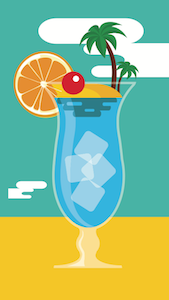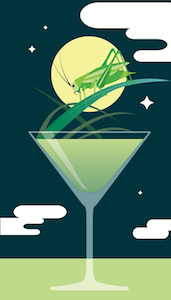
Murder on the Dancefloor
Having all the subtlety of a Bee Gees bouffant, the cocktails of the 70s were perhaps the least likely contenders for a comeback. Yet Hamish Smith finds otherwise
.......................................................
THE HAIR WAS BIG, THE SHOES TALL, THE TROUSERS WIDE, THE SHIRTS LOUD AND THE DRINKS AS BRASH AS THE NEON-CHEQUERED DANCE FLOOR BENEATH THEM.
Every industry has its dark age. For cocktails, the dark age was also the bright age – soupy saccharine concoctions made from powdered mixes or a rainbow of liqueurs and syrups. Umbrellas were required to hide their radiating embarrassment.
These were the Disco Years of the 1970s but it wasn’t until the late 1990s that the industry pulled itself off the dancefloor and headed back to the bar. A new breed of bartender was born. Often termed ‘mixologists’ (though this word dates to the 19th century) the modern, serious bartender rejected the Disco Years and became ingredient-conscious and knowledge-thirsty.
They say the industry hasn’t looked back since, but in moving forward that’s exactly what it did. First to Jerry Thomas et al and the pre-Prohibition clas sic era. There’s been European reminiscing with the likes of Belle Epoch, Prohibition itself and the clandestine drinking dens they produced, Cuban classics, and even tiki. In an industry so bent on continual renewal, it was probably only a matter of time before the dark ages of the 1970s to 1990s were revisited. So here we have it: disco drinks are back. But is it still murder on the dance floor?
The esteemed historian and drinks commentator David Wondrich has raised his concerns. Earlier this year, his Esquire article enti- tled The Misguided Return of the Crappy Drink questioned the sense of returning to the scene of the neon crimes of the 1970s.
He said we’re seeing bartenders “reach back into the Dark Ages with some vague idea of making better – that is, modernised – versions of the shooters and disco drinks that this whole craft cocktail thing was created to avoid”. He added: “But here’s the problem: those drinks resist craft. The point was not to create interesting combinations of flavours you could savour but rather to dis- guise cheap booze in ways that would get you blitzed.”
So perhaps going retro is a retrograde step for an industry that has come so far to prove its skills and craft. The counter argument is that no drink should be off-piste and if they make people happy, that’s all that matters. Educating the customer may have given way to bartending liberalism.
Few decent cocktail bars are producing Blue Lagoons, Grasshoppers, Long Island Iced Teas, Slippery Nipples and B52s to recipes verbatim. Mostly they are taking the concept and refining the ingredients, taking their knowhow and access to ingredients and creating the best Slippery Nipple anyone has got their lips around.
But to Wondrich: “If you replace the Midori in a melon ball... with a house-made bitter-melon cordial, sure, you’ll probably ‘improve’ the flavour of the drink. But who needs a better melon ball?” Partly this trend is down to bartender boredom with classics, reach- ing for another era’s drinks to manicure and make their own. But it’s more profoundly a sense that drinks are supposed to be fun, not serious, and the time of the moody mixologist, fas- tidiously preparing drinks while customers fall unconscious, is over. As World Class 2014 champion Charles Joly tells us: “Don’t take the fun and romance out of bartending. We are making drinks, not performing surgery.”
Captain of fun, JJ Goodman (more formerly, owner of the London Cocktail Club group), was an early advocate of the retro drink. He likes a West Indian Yellow Bird and says his work with retro drinks involves evolving the taste – such as using absinthe in a Blue Lagoon, which, in his inimitable style, he says “will rock your world”. Indeed, 10 years ago, an absinthe blue lagoon would less have rocked your world, more rocked the boat.
But times change. Arnd Henning Heissen of Ritz Carlton Berlin’s Curtain bar, believes all drinks should be fun “as long as you make your guest happy, like my Sex on the Beach”. The drink Heissen is referring to is served in a shell and has a condom (packaged, thankfully) as a garnish. He says that putting a smile on guests’ faces is the most important thing as “they create the atmosphere in your bar”. Elliot Ball, owner of Cocktail Trading Company in London, which is about to open its second site, says: “An insistence on pretentious obscurity was a natural reaction to coming out of the dark ages, and hopefully we’ll see disco gloriously rise from the ashes of sweet and sour mix.” Joining in is Ryan Chetiyawardana, of White Lyan and Dandelyan, who says there was an element of “making shit drinks because it’s ironic” but agrees that, if made well, disco drinks are a force for good.
Max Warner, global brand ambassador for Chivas Regal and one of the most travelled men in the industry, has watched the trends come and go. “I’m always fascinated about how trends spread across the world. “I can’t help wondering whether we have exhausted flavours and the sense of having fun with drinks again – whether blue (keep up the good work Jacob Briars) or crushed/slushy is thanks to the great inspiration of Coughlin and Flanagan [Tom Cruise’s 1988 film Cocktail].”
Certainly, if the best bars in the world, such as Chicago’s Aviary and London’s Artesian, have slushy machines, then really the dumbing-down argument starts to look flimsy. Over at New York bar Dead Rabbit, which serves high-end cocktails upstairs and more approachable drinks and beer downstairs, Jack McGarry says bartending is not really about the liquid in the glass. “I believe the overall emphasis on hospi- tality is key rather than any specific drinks trend.
“As much as I’ve noticed disco drinks, low-proof options, non-alcoholic options etc, this is all happening to make the guest experience more textured and absolute. I believe drinks can be serious in formula and format but delivered in a hospitable way that takes the seriousness or pretentiousness out of the environment. As with many things in life, it’s all about the delivery.”
Cocktail competitions are always a good indicator. At the recent Chivas Masters, Warner set the challenge to create drinks across four cocktail eras, of which the Disco Years was one. Warner gives us a steer on the thinking behind including the least credible of all eras. “Disco Years gave the contestants the opportunity to research a period which was more about flamboyance and style than substance and consistency. Watching the bartenders of the world recreate their interpretation of Disco based on dated imagery, mostly confused yet colourful combinations of ingredients and com- pletely impractical glass- ware was entertaining on its own. I was even happy to score them well if the drink wasn’t that well balanced, providing it amused me.
“I was brought up and educated in drinks via the Nags Head through Del Trotter and Only Fools and Horses. Does anyone know what’s in a Caribbean Stallion? Does anyone even care? I would order it though...” Perhaps it’s because it’sa whisky competition, but it’s notable that tiki didn’t figure in the Chivas Masters. Is disco the new tiki?
Russell Burgess of London’s Loves Company certainly thinks so. “Disco is fast replacing tiki as the go-to fun and kitsch style of cocktails. Is it a good thing? It’s nice to have the other end of the spectrum catered for.” Indeed, Luca Missaglia, who runs the Aqua bars in Hong Kong and London, thinks all drinks are about context and occasion and says the most important part of designing any cocktail is the balance. “A lot of these [disco] drinks were not designed in a skilled way so you just have to make it a good drink. But it’s the same with drinks from the 1930s – you don’t just repeat classic recipes [without modification].”
All the major eras of cocktail culture have been revisited, so really it was a matter of completing the set. Anyway, there is a redemptive quality to righting the wrongs of the bartending forefathers – even if this is to be a fleeting dalliance with disco. The wider observation is that now no drink is off limits. The only taboo is an unhappy customer.
